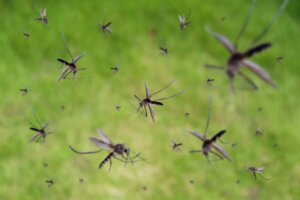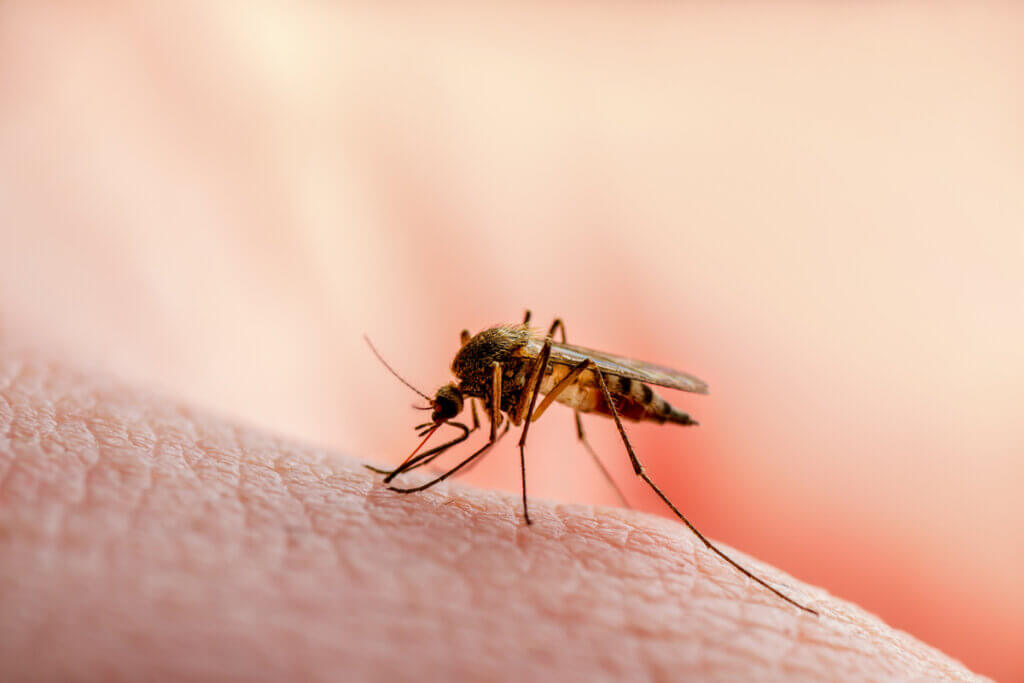The Symptoms, Treatment and Causes of Malaria

Malaria is an infection caused by a common parasite in tropical and subtropical countries. According to the World Health Organization (WHO), each year 229 million people are infected, with an average of 409,000 deaths. It is one of the greatest problems to be overcome in countries of Latin America, Asia and Africa. Find out all about the causes of malaria, along with its symptoms and treatment.
The most vulnerable group is children, although everyone can be infected by the parasite. The disease can be prevented by breaking the chain of vectors, as well as with awareness campaigns and antimalarial drugs.
Causes of malaria
The causes of malaria are any one of five species of parasites that are transmitted through the Anopheles mosquito (female only). However, the WHO states that two of the agents account for most of the cases:
- Plasmodium falciparum: Responsible for 99.7% of cases in Africa, 71% in the Eastern Mediterranean, 65% in the Western Pacific, and 50% in the South-East Asia region.
- Plasmodium vivax: Responsible for infections in the American continent, with about 75% of all cases reported annually.
Along with the others, these species of the parasite travel in Anopheles mosquitoes and infect humans when biting them. As the Centers for Disease Control and Prevention of the United States (CDC) remind us, as soon as they enter the body they take refuge in the liver and begin to multiply rapidly.
The offspring of the parasites are then released into the bloodstream, infecting the red blood cells, multiplying and destroying them. They do this repeatedly until the dead cells release toxins that trigger the immune response. It’s at this point that the patient develops the symptoms of the disease.
Only when parasites invade the bloodstream do people manifest the signs of infection. Pathogens can last up to a month in the liver to reproduce. When it leaves it, they use part of the membrane of the cells they infected to get out.
When a mosquito feeds on the blood of an infected person, the cycle begins anew. This is the only mechanism that generates malaria, so it isn’t possible to contract the disease through any other channel.

Symptoms of malaria
As we have already indicated, malaria symptoms only occur when parasites invade and destroy red blood cells in the bloodstream. This usually occurs from a couple of weeks to a month after infection. Some species of Plasmodium can last up to a year or more incubating in the liver and their manifestations are milder.
According to Johns Hopkins Medicine, the most common symptoms are:
- Headache
- Fever with chills
- Fatigue and muscle pain
- Sickness
- Vomiting
- Diarrhea
The signs are identical to those of the flu. The development and evolution is very similar, although generally there are cycles that oscillate between 6 and 24 hours.
Some common complications are anemia and thrombocytopenia. In severe cases, it can lead to kidney failure, coma, cerebral malaria, and death.
Diagnosis of malaria
Researchers agree that malaria isn’t an easy disease to identify. Most episodes develop with mild or moderate symptoms, so they can be mistaken for the flu. Their detection may be more difficult in non-endemic regions.
Malaria can be detected through a complete blood count profile and microscopic examination by blood smear. The former is useful for assessing the sequelae of infection, while the latter allows parasites to be distinguished with the help of a sample.
Rapid detection kits are popular in certain locations. They are known as rapid diagnostic tests and are of great help to counteract the lack of equipment that allows the other tests to be carried out.
Treatment options
The goal of malaria treatment is to eliminate parasites from the body and stabilize symptoms. The WHO provides extensive guidance for coping with the disease according to location, type of parasite, the severity of symptoms, previous conditions, age, and other special contexts.
Generally, the use of the following drugs is preferred:
- Quinine
- Doxycycline
- Clindamycin
- Sulfadoxine-pyrimethamine
- Artemether-lumefantrine
- Atovaquone-proguanil
Chloroquine was long used as the gold standard for treating malaria. Today, many people are resistant to the drug, so combination therapy is preferred. Researchers agree that drug efficacy tends to be overestimated in non-endemic countries.

Can it be prevented?
There are many ways to prevent malaria. As an immunity against the parasite doesn’t develop, you can be infected several times if you don’t take preventive measures after treatment.
Stanford Health Care recommends the following:
- Get vaccinated or medicated if you plan to travel to an endemic country
- Use mosquito nets around the bed to avoid bites
- Apply insect repellants to exposed skin
- Wear long-sleeved shirts and long pants at night
If you take this into account, you will reduce the chances of contagion in the future. In endemic areas, it is suggested that plans be put in place to break the chain of contagion of the different vectors.
Malaria is an infection caused by a common parasite in tropical and subtropical countries. According to the World Health Organization (WHO), each year 229 million people are infected, with an average of 409,000 deaths. It is one of the greatest problems to be overcome in countries of Latin America, Asia and Africa. Find out all about the causes of malaria, along with its symptoms and treatment.
The most vulnerable group is children, although everyone can be infected by the parasite. The disease can be prevented by breaking the chain of vectors, as well as with awareness campaigns and antimalarial drugs.
Causes of malaria
The causes of malaria are any one of five species of parasites that are transmitted through the Anopheles mosquito (female only). However, the WHO states that two of the agents account for most of the cases:
- Plasmodium falciparum: Responsible for 99.7% of cases in Africa, 71% in the Eastern Mediterranean, 65% in the Western Pacific, and 50% in the South-East Asia region.
- Plasmodium vivax: Responsible for infections in the American continent, with about 75% of all cases reported annually.
Along with the others, these species of the parasite travel in Anopheles mosquitoes and infect humans when biting them. As the Centers for Disease Control and Prevention of the United States (CDC) remind us, as soon as they enter the body they take refuge in the liver and begin to multiply rapidly.
The offspring of the parasites are then released into the bloodstream, infecting the red blood cells, multiplying and destroying them. They do this repeatedly until the dead cells release toxins that trigger the immune response. It’s at this point that the patient develops the symptoms of the disease.
Only when parasites invade the bloodstream do people manifest the signs of infection. Pathogens can last up to a month in the liver to reproduce. When it leaves it, they use part of the membrane of the cells they infected to get out.
When a mosquito feeds on the blood of an infected person, the cycle begins anew. This is the only mechanism that generates malaria, so it isn’t possible to contract the disease through any other channel.

Symptoms of malaria
As we have already indicated, malaria symptoms only occur when parasites invade and destroy red blood cells in the bloodstream. This usually occurs from a couple of weeks to a month after infection. Some species of Plasmodium can last up to a year or more incubating in the liver and their manifestations are milder.
According to Johns Hopkins Medicine, the most common symptoms are:
- Headache
- Fever with chills
- Fatigue and muscle pain
- Sickness
- Vomiting
- Diarrhea
The signs are identical to those of the flu. The development and evolution is very similar, although generally there are cycles that oscillate between 6 and 24 hours.
Some common complications are anemia and thrombocytopenia. In severe cases, it can lead to kidney failure, coma, cerebral malaria, and death.
Diagnosis of malaria
Researchers agree that malaria isn’t an easy disease to identify. Most episodes develop with mild or moderate symptoms, so they can be mistaken for the flu. Their detection may be more difficult in non-endemic regions.
Malaria can be detected through a complete blood count profile and microscopic examination by blood smear. The former is useful for assessing the sequelae of infection, while the latter allows parasites to be distinguished with the help of a sample.
Rapid detection kits are popular in certain locations. They are known as rapid diagnostic tests and are of great help to counteract the lack of equipment that allows the other tests to be carried out.
Treatment options
The goal of malaria treatment is to eliminate parasites from the body and stabilize symptoms. The WHO provides extensive guidance for coping with the disease according to location, type of parasite, the severity of symptoms, previous conditions, age, and other special contexts.
Generally, the use of the following drugs is preferred:
- Quinine
- Doxycycline
- Clindamycin
- Sulfadoxine-pyrimethamine
- Artemether-lumefantrine
- Atovaquone-proguanil
Chloroquine was long used as the gold standard for treating malaria. Today, many people are resistant to the drug, so combination therapy is preferred. Researchers agree that drug efficacy tends to be overestimated in non-endemic countries.

Can it be prevented?
There are many ways to prevent malaria. As an immunity against the parasite doesn’t develop, you can be infected several times if you don’t take preventive measures after treatment.
Stanford Health Care recommends the following:
- Get vaccinated or medicated if you plan to travel to an endemic country
- Use mosquito nets around the bed to avoid bites
- Apply insect repellants to exposed skin
- Wear long-sleeved shirts and long pants at night
If you take this into account, you will reduce the chances of contagion in the future. In endemic areas, it is suggested that plans be put in place to break the chain of contagion of the different vectors.
- Guidelines for the Treatment of Malaria. 3rd ed. Geneva: World Health Organization; 2015.
- Tangpukdee, N., Duangdee, C., Wilairatana, P., & Krudsood, S. Malaria diagnosis: a brief review. The Korean journal of parasitology. 2009; 47(2): 93.
- Whitty CJ, Lalloo D, Ustianowski A. Malaria: an update on treatment of adults in non-endemic countries. BMJ. 2006 Jul 29;333(7561):241-5.
Este texto se ofrece únicamente con propósitos informativos y no reemplaza la consulta con un profesional. Ante dudas, consulta a tu especialista.







